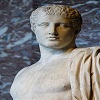Chaos
The First Being
In the beginning of time (or if you can wrap your brain around the idea of having negative-time), the universe wasn't even a universe yet. Instead, there existed a colossal jumble of everything, anything and nothing at all, together at once and all in the same place.
Silence and loudness existed together, as did every color ever imagined, as did no color at all. No patterns, no reason, no right and no wrong. This unbelievable mess of energy, sound, color, texture (and lack of those things) was called CHAOS (Kay-oss). Chaos was all there was.
Chaos wasn't alive necessarily and yet it was. It wasn't male or female, or both or neither. It didn't have a face, or feelings or ambitions. Yet it did. It was ALL and NOTHING. Understand? By now, trying to think of those things has probably given you a nice throbbing headache (it's given philosophers, scientists and thinkers headaches for centuries, so you're in good company)!
An eternity of Chaos had existed, until one day...it didn't. Out of the total disorder of Chaos came...order. For the first time in ever and never, something new happened! Something with form that was actually SOMETHING came out of the rambling mess. This being was TIME itself, the first being with thought and a sense of what was going on.
His name was Chronos, and he set off time as we know it: past, present and future. Once Chronos' "clock was ticking," more beings came out of Chaos (which was getting less and less chaotic by the minute!) to really get the game of Greek mythology (and their whole world and understanding of it) started up.
From out of the void of Chaos came a male being known as Ouranos, the Sky and Heavens and a female being known as Gaea (Earth). These were the gifts that Chaos first gave birth to, who would go on to become husband and wife, reproduce and populate themselves (because Gaea WAS the world!) with all of the Titans, gods, monsters, heroes and other beings in the universe (real or mythological)!
From Chaos came reality! Two more beings came out of Chaos and finally spelled death for the insanity (and sanity) that it was: Erebus, who was actually Darkness and wife, Nyx, the night. These two blotted out and erased what was left of Chaos, effectively killing it dead so that the new universe could live. These first four beings were called the PROTOGENOI (Pro-toe-jen-oy, "First Beings"). And from there...well, EVERYTHING ELSE happened!
So thanks, Chaos, for being there to kick off time and all that is real, and for not being there, and both (and neither)! Now, reader, take two aspirin for that headache!
[1]
More About Chaos
The general public is usually familiar mostly with the so called Olympian gods and goddesses along with a few others, but the Greek pantheon includes also other lessed known deities.
Some of them were "lesser know" for even the ancient Greek, as there wasn't proper cult or organized worshipping connected to these deities. One of these is Khaos (Chaos). There's rather little information available in our time about Khaos, considering her part in the birth of the world and other deities in the Greek mythology.
The earliest written references on Khaos can be found in the book "Theogony" by Hesiod, who lived in the 700's before common era. In Theogony, Hesiod describes the birth of the world and the Gods, as well as Greek mythology.
The word "Khaos" means space, gap, darkness and void, referring to Khaos as that which is between heaven and earth. Khaos was also calles - albeit rarely - as Poros ('passage, contriver, intriguer') and Aeros ('air').
When the world begun, Khaos was there. She is the goddess who predates everything else - gods and even the world. After Khaos arose Gaia (earth), Eros (love) and Tartaros. Without a mate, Khaos gave birth to Erebos (darkness) and Nyx (night). From the love between these two, were born Aether (light) and Hemera (day; according to Bacchylides, Hemera's father is Khronos).
Nyx also bore other children - Moros, Ker, Thanatos, Hypnos, the Oneiroi, Momos, Oizys, the Hesperides, the Keres, the Moirai, Nemesis, apate, Philots, Geras and Eris1, who are all spirits affecting human lives (daimones).
Hyginus, who wrote in Latin in the 100's, relates a slightly different story in his listing of gods Mythographi Fabularum Liber. He wrote: "Ex Caligine Chaos" - Khaos woas born out of moisture, fog. Hyginus continues to tell how out of Khaos and fog were born also Nox (Nyx), Dies (day, Hemera), Erebus (Erebos) and Aether. That is, Khaos is the mother of not only night and darkness, but also day and light.
Khaos with her offspring form the more "etheric" side of the world in the Greek mythology, consisting of deities of seasons, personifications of states of consciousness (from dreams to deaths) and spirits of feelings and states of mind. Some sources do say, that Khaos was originally an ancient goddess of ear, mist and fog.
There are few mentions of Khaos in addition to her role in the birth of the world. In his account of Zeus' fiery fight with the titans, Hesiod describes how an astonishing heat took over Khaos and how it seemed as though Gaia and Ouranos had rushed towards each others and met.
This gives an impression of Khaos moving away from her usual place between earth and heaven. Later on Hesiod tells that titans who lost the battle are now residing behind the gloomy Khaos, far away from all the gods.
In his Birds, Aristophanes offers a glimpse of Khaos as something other than "the first one of all, who merely exists". He gives and account of the beginning of times, when the only ones existing were Khaos, Nyx, the dark Erebos and the deep Tartaros.
There was no earth, air or sky yet existing. The dark-winged Nyx laid and egg in the bosom of Erebos' endless depths and after times had passed, gold-winged Eros hatched from this egg. Eros made love with Khaos in Tartaros and Khaos has wings as golden as those of Eros. This union gave birth to the birds - the first ones to see the light.
Birds tells about birds and at this point, relates the story from birds' point of view, so describing the gods as having bird-like wings makes sense. However, many Greek deities, especially those who descended from Khaos, were often depicted having wings, so Aristophanes' story can give you a clue of what Khaos might look like.
Khaos is also present in the story of Alkmene, the woman who got seduced by Zeus who took the form of her husband and who then bore Zeus' son Heracles. Zeus had just won the battle with the titans: the highest among the gods were now the Olympians and on the top-most spot was Zeus himself.
However, he was well aware that those closest to Gaia's (the source calls them "relatives") Okeanos (sea), Nyx and Khaos still existed, hiding and lurking at the far corners of the universe and that some day, the gods would be defeated like the titans were.
Later sources often describe Khaos as nothing but a chaotic mixture of the elements - lifeless and formless, nothing-yet. Khaos is described as merely a state before the world and order, not as a goddess or even a deity.
Paraphrasing Ovid (from his book Metamorphosis): before there sea, earth or the heavens arrived, there was only the uniformly desolate Khaos, primitive and undeveloped. Khaos didn't achieve anything other than heaviness and just being a tangled mass of all the elements.
These later accounts may be the result of the increasing importance of the Olympic gods in the expense of other, earlier gods. "Khaos as an impersonal nothingness, the beginning of it all but lifeless" is the description you are quite likely to run into in books dealing with Greek mythology (if there actually is any mention of her), as well as in general books on mythology.
[2]












